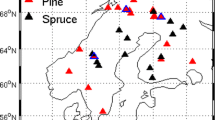Abstract.
The climate of Labrador is uniquely influenced by Labrador Sea atmosphere–ocean dynamics and related sea surface temperature, sea ice and atmospheric fluctuations in the northwest Atlantic. Here we describe composite ring width and maximum latewood density white spruce records averaged over five (four for density) treeline sites in northern Labrador, spanning the past four centuries. These records correlate significantly with surface air and sea surface temperature records for the northwest Atlantic as well as with the North Atlantic Oscillation (NAO). Temperatures over Labrador appear to have been influenced by climate processes operating on interannual to multidecadal time scales over the length of the tree-ring record. The ring width composite reveals a significant (>99% level) mode of variation centered at around 40–60 years which appears to be robust over the full length of record and may correspond to multidecadal modes identified in model and instrumental studies of North Atlantic climate. The density composite indicates significant peaks at about 21–24, 9 and 2–3 years, which generally correspond to spectral modes identified for the NAO. This density series also shows a significant (>99% level) mode of variation at 3.6 years, which is statistically coherent with the winter (DJF) Southern Oscillation Index. This mode decreases in amplitude in the 1800s period of the Little Ice Age, one of the lowest growth periods in the Labrador tree-ring series as well as other northern temperature proxies. This period was also a time of diminished solar activity and several major volcanic events, including the eruption of Tambora in 1815. The ensuing summer of 1816 was the coldest over the past four centuries as inferred from the Labrador density composite. Hardships suffered by Labrador Inuit resulting from the extreme cold period of 1816–17 are mentioned in Moravian mission records. Archaeological and ethnohistorical data also document shifts in the subsistence practices and settlement patterns of Labrador Inuit throughout the 1800s. Many of the cultural changes have been attributed to the effects of European settlement of the region, but may also be a response to the severe climatic conditions during this time.
Similar content being viewed by others
Author information
Authors and Affiliations
Additional information
Electronic Publication
Rights and permissions
About this article
Cite this article
D'Arrigo, .R., Buckley, .B., Kaplan, .S. et al. Interannual to multidecadal modes of Labrador climate variability inferred from tree rings. Climate Dynamics 20, 219–228 (2003). https://doi.org/10.1007/s00382-002-0275-3
Received:
Accepted:
Issue Date:
DOI: https://doi.org/10.1007/s00382-002-0275-3




